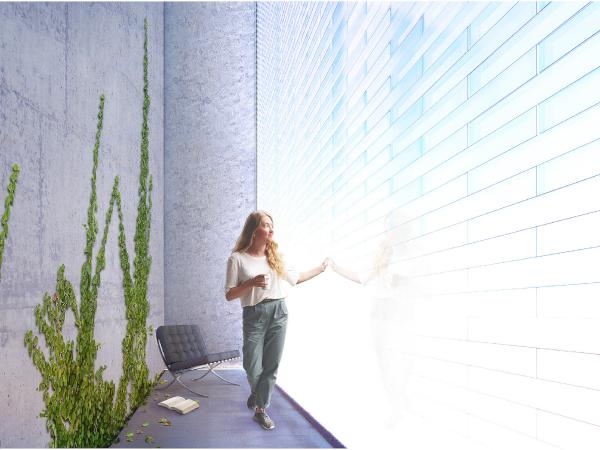
Date: 12 June 2023
Glass bricks have long been popular in architecture for bringing more light into buildings. Until now, however, they have not been suitable for load-bearing walls and have not insulated well. An Empa team has now developed a translucent glass brick with good insulation properties thanks to aerogel, which can even be used for load-bearing elements. This makes it possible to build aesthetic, translucent walls that reduce the need for artificial lighting inside the building.
Glazed construction elements are a popular method in architecture for letting light into a building. This allows for better use of environmentally friendly daylight, and less artificial lighting is needed. To maximize this advantage, however, the glass elements should preferably be used to construct entire walls for the building envelope, which requires that the elements have effective thermal insulation and can bear a certain load - a combination that has not been available on the market in this way until now.

Both requirements met: highly insulating and translucent
Silica aerogels are high-performance thermal insulation materials that are becoming increasingly popular in the construction sector. The most common are opaque insulating mats and plasters. Back in 2017, Empa researcher Jannis Wernery and his colleagues from the Building Energy Materials and Components department had the idea of integrating the insulating material directly into a building brick and presented a new type of brick filled with aerogel, the so-called "Aerobrick". Thanks to its excellent thermal insulation, this brick saves heating costs - without the need for an additional insulation layer applied to the masonry.
However, aerogel can also be virtually transparent, which makes for a translucent, insulating building system. To take advantage of this and further improve the insulating performance of the "Aerobrick," Wernery, Michal Ganobjak and Co. developed a novel modular component based on float glass and silica aerogel granules that combines both properties - it is translucent and insulating: the aerogel glass brick.
The glass bricks filled with translucent aerogel granules allow the construction of aesthetically pleasing and even load-bearing façade elements that enable a significant amount of daylight to enter. The Empa researchers achieved this combination of strength, insulation and light transmission by using offset spacers between the glass panes within the glass brick, which ensure static stability with minimal heat transmission.
The glass brick has a measured thermal conductivity of 53 mW/(m∙K) and a compressive strength of nearly 45 MPa. This is the highest insulating performance of any brick found in the technical literature, let alone on the market. Additionally, it comes with the property of light transmission.
Multiple applications in view
The aerogel glass brick is suitable for applications in which there are simultaneous requirements for high daylight penetration, glare protection and privacy protection, such as in offices, libraries and museums. An important aspect is that a building envelope made of such glass bricks couples the inside of the building with the outside in terms of daylight. This can have a positive effect on the circadian rhythm of the building users. Possible applications include
- Rooms that should not have a line of sight to the outside, for example for reasons of privacy, security or to avoid disturbances, but should still allow diffuse daylight into the interior, such as libraries, galleries, museums, foyers, offices, stairwell cores, gymnasiums, multi-purpose halls, residential buildings or art workshops
- Spaces where daylight is necessary for a healthy circadian rhythm, such as dormitories, hospitals and sanatoriums, as well as zoos, stables and animal breeding facilities, and even greenhouses
- Places where maximum daylight is to be brought in and space is to be saved, such as in densely built-up urban quarters with high-rise buildings and many city apartments
- Architectural elements such as Trombe walls in solar architecture, courtyards or atriums that generate heat from infrared radiation from sunlight
An analysis of material costs shows that the insulating glass brick can be quite competitive in such applications. The glass brick thus offers architecture new design possibilities for more daylight in buildings - both for new buildings and renovations. The researchers have now filed a patent application for the aerogel glass brick and are looking for potential industrial partners.
The project is supported by the Velux Stiftung, Project No. 1440 for the development of a highly insulating translucent glass brick for diffusive daylighting. The project idea was developed with support from the Horizon 2020 Research and Innovation Program of the European Union under the Marie Skłodowska-Curie Actions, contract number 746992.
 600450
600450




















Add new comment